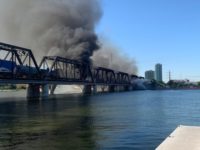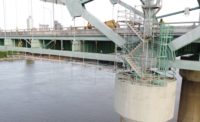 azcentral.com ADOT investigators want to determine what caused girders to fall.
|
Officials remain puzzled over an Aug. 9 bridge collapse in Mesa, Ariz. Early signs point to a construction incident rather than structural failure. On Thursday, around 8:30 a.m., a 114–ft–long bridge section that was under construction fell for no apparent reason. No one was injured. Nine of 11 pre-cast, pre-stressed girders of a future bridge on the Loop 202 Red Mountain Highway, just east of Power Road, dropped 25 ft from their pier caps. The girders on the westbound lanes of the 87.8-ft-wide bridge—each 2.5-ft-deep and 105,000-lb—had been placed atop the pier caps three weeks prior.
The bridge had been awaiting final bracing with concrete diaphragms when the girders fell in succession like dominoes. There was no wind or seismic activity. The construction sequence called for girders to overhang pier caps by 2.8-ft to 2.11-ft. until they could be permanently secured. No work had occurred while awaiting the diaphragms which are cast in between girders and ends and tied together with rebar, says Doug Nintzel, Arizona Dept. of Transportation spokesman. Leaving girders resting unsecured for a time is common industry practice, say officials.
|
"We're uncertain what triggered the collapse, but a full investigation is now under way," says Nintzel. No word on how long the investigation will take, although it will be joint effort conducted between ADOT and general contractor, Pulice Construction Inc., Phoenix.
"As with all ADOT projects, officials will conduct a rigorous inspection of the bridge before approving it," says Nintzel. "The incident will not affect the completion date of the final segment of the Loop 202, which is expected to open in late summer 2008."
The Power Road bridges carry three lanes of traffic in each direction, and use straddle bent piers due to "the large skew of the roadway and the long span," says Mark Soyster, Pulice’s vice president of operations. The four straddle bents are comprised of a series of girder plys bolted together to literally straddle the CAP canal. "Then we built the pier columns on top of the straddle bents and then built the pier caps on top of those," Soyster adds.
The collapse won't affect Gov. Janet Napolitano's order last week for ADOT workers to inspect all Arizona bridges. That order came after a bridge collapse last week in Minnesota, where at least five people were killed. ADOT has 4,720 interstate and state highway bridges with less than 1% listed as "structurally deficient," meaning they need some type of repair.
Girders fell into the Central Arizona Project’s (CAP) nearby canal, leaving portions of the overpass hanging. The girders cracked upon impact and will be replaced at the contractor's expense, which is estimated at $185,000. Pier caps sustained only minor scraping. Royden Construction Co. is the Phoenix-based subcontractor responsible for girder manufacturing and erection. Pulice, however, is overseeing general construction of the 4.83–mile, $195–million project that completes the final Loop 202 segment between Power Road and University Drive. In February, Pulice had replaced a defective bridge pier earlier that lacked the sufficient amount of reinforcing rebar.The contractor discovered the problem, removed and rebuilt the pier at their expense, which ran roughly $100,000, Ninztel says. Related Links:
Related Links: 



Post a comment to this article
Report Abusive Comment